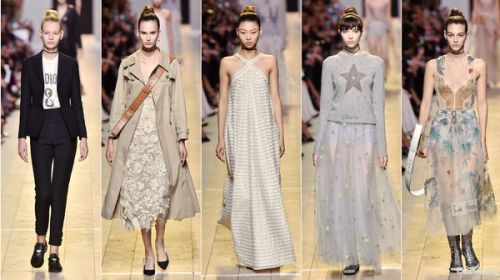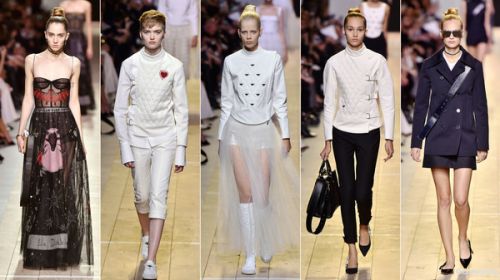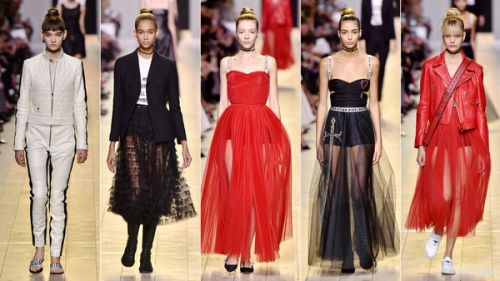“I think fashion is about change. Fashion is about revolution. And I think that revolutionary is a woman. I’m a little bit feminist because I’m a woman at Dior and so I wanted to speak about the women in a different way.”
The feminist speaking was Maria Grazia Chiuri, the 52-year-old Roman-born designer who has arrived at Dior as creative director of womenswear. As the first woman to lead the house in Dior’s 70-year history, Chiuri now holds one of the biggest jobs in fashion: Dior brings in combined annual revenues of around €5bn, of which a big chunk is Grazia Chiuri’s responsibility.
The house is well ready for a revolution — albeit of a gentle, couture-glove-handed one. In recent years it has weathered the scandal of John Galliano’s racist outburst and subsequent dismissal, and the resignation of designer Raf Simons (Galliano’s successor, who quit last October after almost four years). Financially, its growth of late has been meagre: Dior reported a very modest 2 per cent growth in revenues in the fiscal year until July 1 2016. With Grazia Chiuri’s appointment come great expectations.
The designer came out fighting. Combative, even. Her first look was a white fencing suit. The jacket was softly quilted in cotton, tied at the sides and embroidered with a little black bee (a logo first used by Hedi Slimane when he worked for Dior Homme in the 1990s). It was worn by a shaven-headed blonde with skinny white knickerbockers and white branded sneakers stamped “Dior”. En garde!
The look introduced a score of fencing variations: some models wore leather gilets over crisp white shirts, some wore quilt vests with straight black trousers, others a peaked visor hat, or with long white tiered tulle.
The looks were fresh yet had a strange formality — a sporty uniform in which to blade through the world. Most were worn with branded lingerie, black straps saying: “J’adior Christian Dior” — equal parts chic and street.
“If you think about Dior, you think about the Bar jacket in white, and the skirt in black,” said Grazia Chiuri of her Visconti-inspired fencers. “I think sometimes the vision of Dior is too close to the ’50s. But you have to propose the Dior codes in a modern way. This is a daytime outfit, it’s contemporary sportswear in a couture attitude.”

Grazia Chiuri was speaking two days before the show in her studio, at the company’s headquarters. She was overseeing final fittings. The room was charged with an atmosphere of cautious concentration, but Grazia Chiuri, with her peroxide bleached-blonde hair and dark kohl-rimmed dark eyes, had punctuated the tension with her easy camaraderie. A model waited for inspection in a long ivory gown of handmade lace. “She looks beautiful,” said Grazia Chiuri admiringly to her head of studio. “Doesn’t she?”
After a long “study”, Grazia Chiuri had found the themes of her first collection by using all her favourite bits of Dior. And hers is a broad church. While the first half of the show featured sporty daywear, slogan T-shirts, sharp monochromatic tailoring and severe, simple gowns, the second indulged a more romantic spirit: a collection of delicate, tulle dresses embroidered with tarot-card illustrations and stars. The stars were a favoured motif of Christian Dior’s, but such celestial themes were also reminiscent of the dresses she delivered so successfully at Valentino.
“I looked at the codes, but I had freedom with them,” she explained. “I know what I like and what I don’t like. I like the sign of the star, so why not? And I love also the cut that Slimane used in the denim, so I used that. I love John Galliano’s newsprint dress that Carrie Bradshaw wore in Sex in the City. And the saying ‘J’adior’ is a sentence that my generation will always have in mind.”
She even managed to justify the comparative lack of colour by tracing it back to the master couturier: “There is some blue, some red,” she conceded. “But Monsieur Dior was not very close with the colour. He loved a lot of blue, with black and ivory and black and white. And red.”
If the collection had a split personality — princess tulles, mysticism, branded lingerie, boxer boots — it reflected real women, argued Grazia Chiuri. “Women don’t want to be only one way. In the morning you might want to be very basic, tonight fairy princess, another time to be a little bit sexy. I’m the same myself. I want to use clothes to give my point of view, but at the same time I like that women use my pieces to create their own personal style. I don’t want to impose something. I want to have a dialogue, to ask them what they want.”

Ask women what they want. Radical, right? It also makes good business sense. The collection pushed the house’s categories in all directions. A former accessories designer, Grazia Chiuri had also given the shoes and bags a major makeover, and the bags — with their chic new CD logo — were an especially good improvement. The couture finish on a black dress with a deep “v” on the shoulders highlighted the atelier’s skill. Grazia Chiuri’s collection had something for everyone, from the mademoiselles of the Avenue Montaigne to the pop kids in Korea, and even the Women’s Libbers: a T-shirt was emblazoned with “We should all be feminists”, the title of Chimamanda Ngozi Adichie’s 2014 essay.
And good for her. Sometimes finding your vision at a vast luxury brand is simply a matter of searching out the codes that work for you. And Grazia Chiuri had found lots of them and made them her own. It was a curiously unselfish show also, one that called upon the ghosts of the house, revisited their contributions and celebrated it all. Was that attitude the result of having shared a credit for so long at Valentino? Or was it just a decent thing to do? Either way, it was impressive. So did I cheer when I saw her Revolution slogan T-shirt sally down the catwalk? Sure as heck I did.


